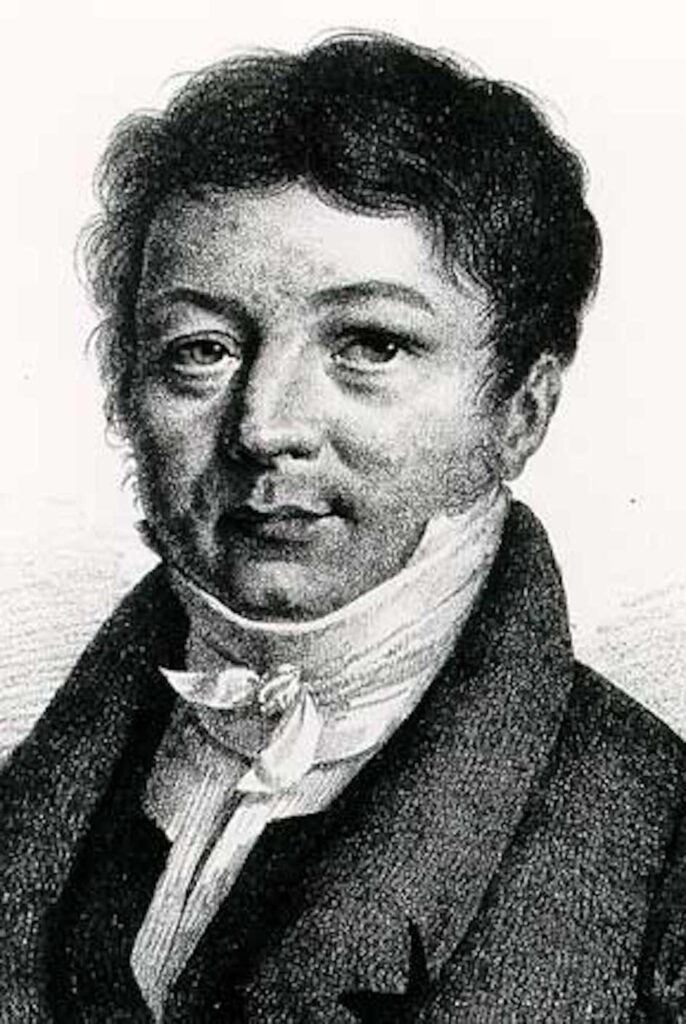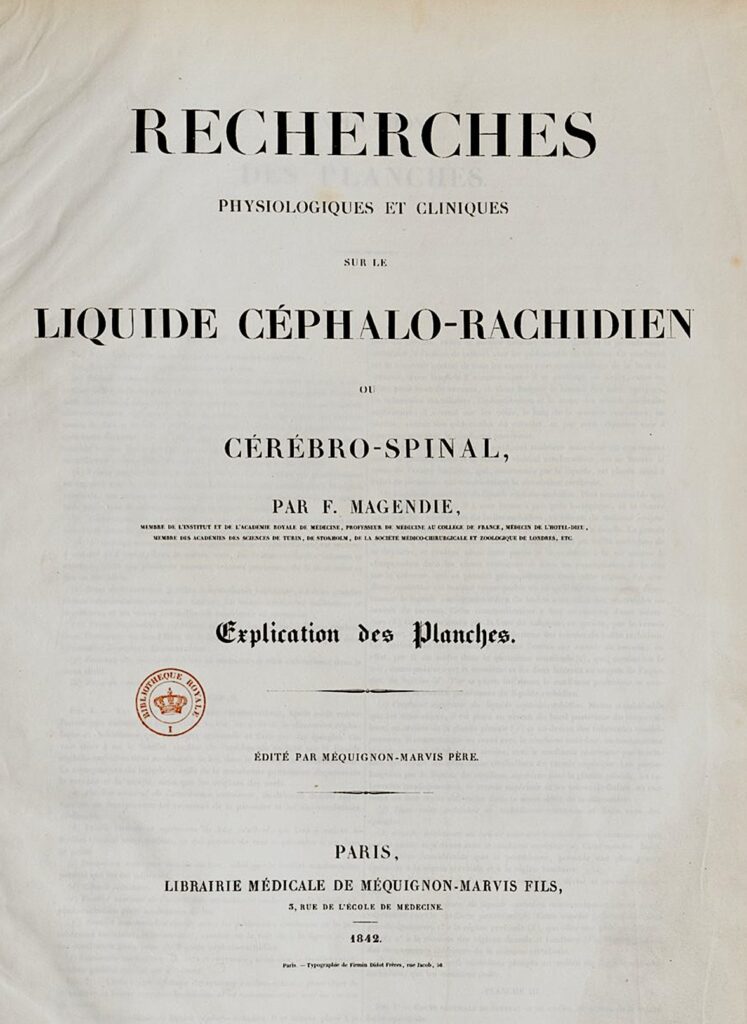JMS Pearce
Hull, England
 |
| Fig 1. François Magendie. Via Wikimedia. |
François Magendie (1783–1855) (Fig 1) was a pioneering French physiologist, pharmacologist, and clinician who carried out a surprisingly wide variety of investigations. His best-remembered works are on the fourth ventricular foramen and the function of spinal nerves.
He was born in Bordeaux, son of a surgeon, Antoine Magendie, and his wife, Marie Nicole de Perey. His father, an ardent republican supporter of the French Revolution, moved to Paris and introduced François to the controversial, anti-materialistic philosophy of Jean Jacques Rousseau (1712–1778).1
Between 1789 and 1796, the revolutionary government dissolved French medical schools as “royalist strongholds.” Prevailing political issues prevented Magendie’s formal education until the age of ten when he attended the local lycée. Aged sixteen, he was apprenticed to a Parisian surgeon, Alexis Boyer, a friend of his father’s, who at the Hôtel Dieu schooled him in anatomical dissections. In 1803 he became an assistant in anatomy at the École de Médecine and began his clinical residency at the Hôpital Saint-Louis. He graduated MD in Paris in March 1808, defending a dissertation entitled Essai sur les usages du voile de palais avec quelques propositions sur la fracture du cartilage des côtes.
These vagaries of his education molded a staunchly independent man, an avid collector of facts with a contempt for unproven theories and social conventions. In his first paper he said: “The majority of physiological facts must be verified by new experiments and this is the only means of bringing the physics of living bodies out of the state of imperfection in which it lies at present.”2 His mission was, by experimental observation and analysis, to replace the popular notions of “vitalism”—the doctrine held by the eminent histologist and pathologist Marie François Xavier Bichat (1771–1802) that the functions of a living organism are due to vital elements distinct from physicochemical forces.
Working with surgeons François Chaussier, Alexis Boyer, and Baron Guillaume Dupuytren, he acquired a practical approach to medicine, much influenced by the ideologues’ philosophy. His animal experimental work began in about 1815–16 with ablations, extirpations, and ligations. In 1811 he became prosecteur at the Faculty of Medicine and also carried out his research at the Hôtel Dieu. He established the first periodical of experimental physiology, Journal de Physiologie Expérimentale, in 1821.
He attained further distinction when he was elected to the French Academy of Sciences in 1821 and served as its president in 1837. He obtained promotion at the Salpêtrière and in 1831 became the first professor of médicine expérimentale at the Collège de France, where his former student Claude Bernard succeeded him in 1855. His Précis élémentaire de physiologie (1816–17) ran to four French editions and was translated into German, Italian, and English.
Of his diverse investigations and discoveries, the most frequently cited are on the fourth ventricular foramen of Magendie, and the function of spinal nerves.
 |
| Fig 2. Diagram of the spinal nerve roots as identified by Bell and Magendie. From Gray’s Anatomy. |
Bell-Magendie hypothesis of spinal nerve functions
Francois Magendie made experimental studies on eight dogs from which he was the first to prove the motor function of the anterior spinal roots and the sensory function of the posterior spinal roots.3 Both Sir Charles Bell (1774–1842) and Magendie distinguished sensory from motor nerves and separated motor from sensory function within the spinal nerve roots. This became the Bell-Magendie hypothesis that showed that reflex movements were independent of the brain.
Bell had found
The nerves of the spine… constitute this original and symmetrical system. All these nerves agree in these essential circumstances; they have all double origins; they have all ganglia on one of their roots; they go out laterally to certain divisions of the body; they do not interfere to unite the divisions of the frame; they are all muscular nerves, ordering the voluntary motions of the frame; they are all exquisitely sensible.4*
However, Bell did not establish the sensory function of the posterior roots though he claimed the discovery. Although he had understood the principles of afferent and efferent pathways in the cord, he initially thought both motor and sensory functions lay in the anterior roots. Only after the publication by Magendie did Bell assert his priority, a claim based on republications of his papers in which the wording had been altered to fit with Magendie’s findings. (Bell also claimed the London surgeon Herbert Mayo’s discoveries of the functions of the fifth and seventh cranial nerves.5)
Magendie correctly related motor function to the anterior roots and sensory function to the posterior roots.
In 1847 Magendie commented:
In sum, Charles Bell had had, before me, but unknown to me, the idea of separately cutting the spinal roots; he likewise discovered that the anterior influences muscular contractility more than the posterior does. This is a question of priority in which I have, from the beginning, honoured him. Now, as for having established that these roots have distinct properties, distinct functions, that the anterior ones control movement, and the posterior ones sensation, this discovery belongs to me.6
 |
| Fig 3. Magendie’s physiological and clinical research on cerebrospinal fluid. |
Cerebrospinal fluid (CSF)
The eighteenth-century anatomist Morgagni and the physician Robert Whytt demonstrated the anatomical CSF pathways within the cranium.7 In 1828, Magendie,8 then Luschka (1855), Key, and Retzius described the CSF flow in the ventricles and subarachnoid space. But Magendie mistakenly believed its formation was by the arachnoid membrane, not by the choroid plexuses. He described the median aperture (“Foramen of Magendie”), which drains CSF from the fourth ventricle into the cisterna magna (Fig 3).9
This in turn led to the understanding of the hindbrain malformation of Chiari and the related hydrocephalus and syringomyelia.
Cerebral gyri
Vicq d’Azyr had described the brain’s convolutions in 1786 noting the differences in morphology in different animals. Magendie in 1824 had wondered whether the number and location of the cerebral gyri might relate to intellect and the workings of the mind:
The number, the volume, the disposition of the circumconvolutions are variable. In some brains they are very large; in others they are less and more numerous. They are differently disposed in every individual; those of the right side are not disposed like those of the left. It would be an interesting research to endeavour to discover if there exists any relation between the number of circumconvolutions and the perfection, or imperfection, of the intellectual faculties—between the modifications of the mind and the individual disposition of the cerebral circumconvolutions.10
This plainly anticipated cerebral localization was later expounded by Hughlings Jackson, David Ferrier, Fritsch, and Hitzig.
A mechanism of coma
The term “coma,” from the Greek koma—or deep sleep—appeared in the works of Hippocrates (Epidemica) and Galen. In the second half of the nineteenth century, coma was attributed to compression, concussion, and commotion of the brain that occurred in head injuries and strokes. Kocher related that Magendie had experimented by compressing a child’s spina bifida sac (meningocele) leading to bulging of the fontanel and somnolence,11 thus relating consciousness levels to raised intracranial pressure. Later, the effect of raised pressure on Morruzzi’s and Magoun’s reticular activating system of the brainstem12 was investigated by Cushing.
Anaphylaxis
Magendie observed anaphylaxis (the allergic reaction to the injection of a foreign protein) when he described in Lectures on the blood; and on the changes which it undergoes during disease (1839) that rabbits able to tolerate a single injection of egg albumin often died following a second injection.
Blood sugar
In 1846 Magendie showed that the presence of sugar in the blood could be a physiological not a pathological occurrence. Assisted by Claude Bernard, he fed starch to a dog and found glucose in its blood. Thus, glucose was a normal constituent of blood, not a sign of diabetes as generally believed. This encouraged Claude Bernard to investigate glycemia and led to his crucial discovery of glycogenesis and glycolysis in the liver.
Experimental pharmacology
In a series of early experiments on animals with the botanist and physician Alire Raffeneau-Delile, he investigated several drugs of vegetable origin: nux vomica and the Saint Ignatius’s bean of the Philippines (both containing strychnine). In 1809 Magendie presented these results to the Académie des Sciences and to the Société Philomatique. Importantly, his experiments for the first time showed that similar effects produced by drugs were dependent on their chemistry, not on the plant from which they originated.
In 1827 he published his popular Formulaire pour la préparation et l’emploi de plusieurs nouveaux médicaments, a therapeutics manual, published in English two years later. Magendie introduced into medicine several recently discovered alkaloids: strychnine, morphine, emetine, quinine, and the insecticide veratrum.
Experimental physiology
In 1813 he resigned from Faculté de Médecine de Paris and gave private courses of experimental physiology based on vivisection.13 Claude Bernard commented in the Rapport sur le progrés et la marche de la physiologie en France: “He attracted many students, from France and abroad. It was from this center that the young physiologists carried the seeds of the new experimental physiology into the neighboring schools, where it then developed with such prodigious rapidity.” Magendie published in 1816 Précis élémentaire de physiologie, which was highly influential.
A man of mixed repute, although well regarded as an intellectual researcher, he was skeptical, stubborn, and at times angry and contemptuous. Magendie was a notorious vivisectionist, injuring animals at public displays to a degree that outraged many of his contemporaries, including Charles Darwin and Thomas Huxley. The Irish MP Richard Martin pilloried his activities; when introducing his bill banning animal cruelty in the UK, he described Magendie’s cruel public dissection of a greyhound a “disgrace to Society.”
He was married to a wealthy widow, Henriette Bastienne de Puisaye, but had no children. He died of heart disease at Saunois, near Paris, aged seventy-two.
Note
* The term “sensibility” did not refer to sensory impulses, as it does today, but to intrinsic “irritability” of nerves and muscles.
References
- Stahnisch FW. François Magendie (1783–1855). J Neurol 2009;256:1950-52. https://doi.org/10.1007/s00415-009-5291-3.
- Magendie F. Quelques idées générales sur les phénomènes particuliers aux corps vivants. Bulletin des sciences médicales1809;4:145-170.
- Magendie F. Expériences sur les fonctions des racines des–nerfs rachidiens. J Physiol Exp Pathol 1822;2:276-9.
- Bell C. On the nerves; giving an account of some experiments on their structure and functions, which lead to a new arrangement of the system. Phil Trans Royal Society 1821;111:398-424.
- Jørgensen CB. Aspects of the history of the nerves: Bell’s theory, the Bell-Magendie law and controversy, and two forgotten works by P.W. Lund and D.F. Eschricht. J Hist Neurosci. 2003;12(3):229-49.
- Magendie F. Comptes rendus de l’Académie des Sciences 1847;24:320.
- Whytt R. Observations on the Dropsy in the Brain. Edinburgh: J. Balfour, 1768.
- Magendie F. Mémoire sur un liquide qui se trouve dans le crâne et le canal vertébral de l’homme et des animaux mammifères. Journal de Physiologie Expérimentale et Pathologique 1825;5:27-37.
- Magendie F. Recherches physiologiques et cliniques sur le liquide céphalo-rachidien ou cérébro-spinal, with an accompanying atlas. 1842. Gallica, Bibliothèque Nationale de France. https://gallica.bnf.fr/ark:/12148/bpt6k6473779t.texteImage.
- Magendie FJ. An elementary compendium of physiology: For the use of students. Trans: E. Milligan. Philadelphia: James Webster, 1824: 104.
- Kocher T. Hirnerschütterung, Hirndruck und chirurgische Eingriffe bei Hirnkrankheiten. In: Nothnagel H, ed. Specielle Pathologie und Therapie, vol. 9, part 3. Vienna: Hölder, 1901: 1-457. Cited in Peter Koehler and Eelco Wijdicks, Historical study of coma: Looking back through medical and neurological texts, Brain 2008;131(3):877-89.
- Moruzzi G, Magoun HW. Brain stem reticular formation and activation of the EEG. Electroencephalogr Clin Neurophysiol 1949;1:455-73.
- Olmsted JMD. François Magendie, pioneer in experimental physiology and scientific medicine in XIX century France. Montana: Kessinger, 2008.
JMS PEARCE is a retired neurologist and author with a particular interest in the history of medicine and science.

Leave a Reply